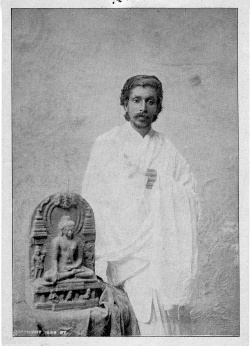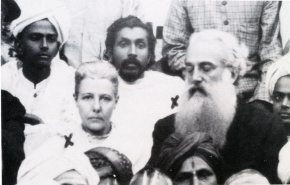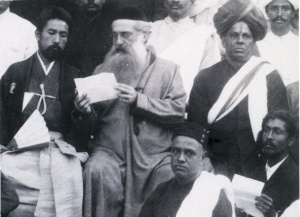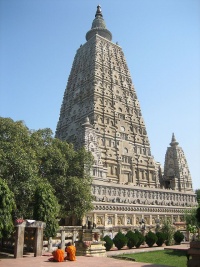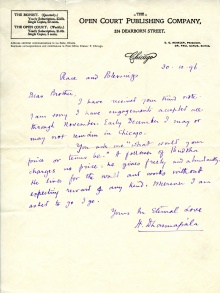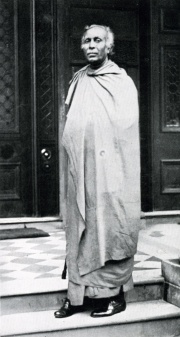Anagarika Dharmapala
ARTICLE UNDER CONSTRUCTION
ARTICLE UNDER CONSTRUCTION
Early life
Theosophical involvement
In 1874, when Dharmapala was a boy, he attended a great debate between Christians and Buddhists that took place in Ceylon. When Colonel Olcott and Madame Blavatsky heard about this some time later, they wrote to the Buddhists Gunananda and Sumangala that, in the interest of universal brotherhood, they would come to Ceylon to help the Buddhists. Dharmapala wrote:
The letters from Colonel Olcott and Madame Blavatsky were translated into Sinhalese and widely distributed. My heart warmed toward these two strangers, so far away and yet so sympathetic, and I made up my mind that, when they came to Ceylon, I would join them.
They did come to Colombo a few years later, when I was sixteen. The Buddhists entertained them royally. I remember going up to greet them. The moment I touched their hands, I felt overjoyed. The desire for universal brotherhood, for all the things they wanted for humanity, struck a responsive chord in me. I began to read their magazine. . . . I pondered on the conversations I had had with the two Theosophists. I made up my mind not to entangle myself in the net of worldly desires. I would endeavor from then on to devote my life to the welfare of others. Exactly how I was to carry out my resolve, I was not certain, but I felt that somehow the way would be found in the writings of Madame Blavatsky.[1]
He, his parents and uncle all worked alongside with Col. Olcott for the Buddhist revival in Ceylon, including the introduction of the Buddhist flag as a unifying symbol, and supporting Buddhist schools. In 1889, Olcott and Dharmapala traveled to Japan in an effort to create an ecumenical "International Buddhist League". Their journey through Singapore, Saigon, Hong Kong, and Shanghai was hard on Dharmapala's health, and when they encountered the winter cold of Japan, the young man had to hospitalized due to severe rheumatism. After returning to South Asia, Dharmapala and Olcott worked to establish the Maha Bodhi Society in 1891.[2]
In 1893 Col. Olcott sponsored Dharmapala to be invited by the managers of the first World's Parliament of Religions in Chicago as a speaker representing Southern Buddhism. He gave lectures both at the Parliament and during the Theosophical Congress held at the time. In a well-attended public ceremony under the auspices of the TS in Chicago, he conducted the first conversion to Buddhism of an American on American soil. The individual in question was Mr. C. T. Strauss, a Jewish haberdasher and member of the Theosophical Society delegation, who would later become an author and leading expositor of Buddhism in the West.[3]
After leaving Chicago he visited Brooklyn, N.Y.. There, he met more members of the Society, attended some meetings, and gave a talk at the Aryan Theosophical Society. He also stopped in San Francisco on his way back home via Japan, where once more he met members of the TS and lectured publicly for them, causing much favorable comment in the newspapers of the West coast. He made a good impression among people who met him, described as one of "gentleness, sincerity, and devotion."[4]
In his subsequent trips to the US, the second one being in 1897, he lectured to Buddhist and Theosophists. By this time, however, tensions had began in his relationship with Theosophy, mainly due to his progressive identification with the Buddhist cause. Scholar David McMahan pointed out:
One of the important factors in his rejection of theosophy centered on this issue of universalism; the price of Buddhism being assimilated into a non-Buddhist model of truth was ultimately too high for him.[5]
Dharmapala eventually broke with the Theosophical Society in 1905.
World's Parliament of Religions in 1893
Dharmapala was invited to speak at the first World's Parliament of Religions, held at Chicago in 1893. He was the first Theravada Buddhist missionary in the United States, and his presence generated high expectations. W. Q. Judge wrote:
Our own beloved brother and Fellow-Theosophist, H. Dhammapala, Secretary of the Maha Bodhi Society, has been commissioned to represent the Southern Buddhist Church. It is expected by the Auxiliary managers that he will be one'of the greatest attractions in the Parliament of Religions, and every courtesy will be extended to him by them during his stay in Chicago. The Local Committee on the Theosophical Congress hope to secure his services also during our sessions.[6]
He sailed to England in July and was warmly greeted by Sir Edwin Arnold, Bertram Keightley, C. W. Leadbeater, and young C. Jinarājadāsa. He stayed in the home of Sir Edwin, and then in London with Annie Besant. Mrs. Besant was indignant to find that his steamer ticket to New York was third class, and she upgraded it to first class. She and Dharmapala arrived in the United States on September 2, greeted by Mr. Judge, and he continued to Chicago by train.
At the Parliament, his talks "The World's Debt to Buddha" and "Buddhism and Christianity" captivated people's attention. Dharmapala tried to make Buddhism appealing to his Western audience. His first talk is full of references to science, the European Enlightenment, and Christianity. He explained to the Parliament that the Buddha had denied the existence of a Creator, and pointed out that the developing evolutionary science was preparing the Western minds for the Buddhist teachings. He remarked:
Accepting the doctrine of evolution as the only true one, with its corollary, the law of cause and effect, he condemns the idea of a creator and strictly forbids inquiry into it as being useless.[7]
He added that Buddhism was "a comprehensive system of ethics and a transcendental metaphysics embracing embracing a sublime psychology".[8]
Through these talks he brought the teachings of the Buddha to the Western world in a massive way for the first time. His work in the USA made him attain international recognition.[9]
Dharmapala also acted as a representative of the Ceylon Section of the Theosophical Society in the two-day congress organized by the TS within the context of the wider Parliament. He spoke twice here, the last one being for a general presentation of Theosophy to the Parliament, with 4,000 present.[10] His opening words were the following:
Brothers and Sisters — A philosophical exposition of this grand subject of Theosophy is not within my province. Abler minds are here to give a Theosophic exposition of that beautiful subject. I am here as a Buddhist. I come to attend the religious Congress as such; but I am here to-day to express my deepest sympathy, my deepest, I should say, allegiance to the Theosophic cause, simply because it made me to respect my own religion. And now look: there are Brahmans here on this platform, and here are my sweet sister, Mrs. Muller, and my brother Chakravarti, one a Brahman and the other a Christian, and by the study of Theosophy she loves it just now more than she used to do.[11]
Maha Bodhi Society
In 1885, Sir Edwin Arnold, author of The Light of Asia, published articles in The Telegraph drawing attention to the Buddha Gaya (Bodh Gaya) Temple, site of Guatama Buddha's enlightenment. The temple had been abandoned and was in deplorable condition. On January 22, 1891, Dharmapala, accompanied by Japanese priest Kozen Gunaratna, visited the site, and felt a tremendous urge to take action. He wrote in his diary,
As soon as I touched with my forehead on the Vajrasana a sudden impulse came to my mind. It prompted me to stop here and take care of this sacred spot so sacred that nothing in this world is equal to this place where Prince Sakyasinha gained Enlightenment under the Bodhi Tree.[12]
On May 31, 1891, the Budh-Gaya Mahabodhi Society was formed. The High Priest of Ceylon H. Sumangala was President, Col. Olcott was Director and Chief Advisor, and Dharmapala was General Secretary. The new Society solicited contributions to maintain a staff at the Buddha Gaya site. The Society convened an International Buddhist conference at Buddha Gaya in October, 1891. Headquarters were established in Calcutta (now Kolkata). A journal, The Maha Bodhi began publication in 1892, with Dharmapala serving as editor for many years.
While staying in England in 1893, he contacted William Rhys Davids, founder of the Pāli Text Society, for advice about the temple.[13] Over the course of a number of years, but eventually the Maha Bodhi Society succeeded in restoring the ancient Buddhist shrines at Bodh Gaya, Sarnath, and Kushinara. Substantial donations by Hawaiian Theosophist Mary T. Foster facilitated this work.
The Maha Bodhi Society in India continues actively in Calcutta, and related organizations are in Bangalore, Colombo, and elsewhere.
Lecturing
Mr. Dharmapala was much in demand as a speaker, particularly after his notable performance in Chicago at the World's Parliament of Religions in 1893. On October 30, 1896, he wrote this response to a request by Dr. J. D. Buck to schedule a lecture:
I have received your kind note. I am sorry I have engagements accepted all through November. Early December I may or may not remain in Chicago.
You ask me "What would your price or terms be." A follower of Buddha charges no price; he gives freely and abundantly. He lives for the world and works without expecting reward of any kind. Wherever I am asked to go I go.[14]
This letter was printed on the stationery of the Open Court Publishing Company in Chicago, which published works of many Theosophists and was highly engaged with the concept of interfaith parliaments.
Writings
Dharmapala was the founder and editor of The Maha Bodhi, journal of the Maha-Bodhi Society for many years. He also wrote for early Theosophical journals. The Union Index of Theosophical Periodicals lists several articles by or about Dharmapala. He also wrote books and pamphlets. Many works are available in Sinhalese. Here are English-language publications in chronological sequence:
- The World's Debt to Buddha. 1893. Lecture at the World's Parliament of Religions.
- The Kinship between Hinduism and Buddhism. With Henry S. Olcott. Calcutta: The Maha-Bodhi Society, 1893.
- History of an Ancient Civilization: Ceylon under British Rule. Los Angeles, 1902. 6 pages.
- The Life and Teachings of Buddha. Madras : G.A. Natesan & Co., 1912.
- The Constructive Optimism of Buddhism. 1915.
- The Arya Dharma of Sakya Muni, Gautama, Buddha or, The Ethics of Self Discipline. Calcutta : Maha Bodhi Society, 1917. 232 pages. Available at Hathitrust.
- Buddhism in Its Relationship with Hinduism. Calcutta : Anagarika Brahmachari Dharmapala, Maha Bodhi Society, 1918.
- The Psychology of Progress, or, The Thirty Seven Principles of Bodhi. Calcutta: Maha Bodhi Society, 1921. 31 pages.
- Message of the Buddha. 1925.
- Evolution from the Standpoint of Buddhism. 1926.
Collections of his writings and lectures:
- Basic Buddhism. [Kandy or Colombo?]: All-Ceylon Buddhist Students' Union, 1945. 31 pages.
- Great sayings of Anagarika Dharmapala. Compiled by Bhikshu Sangharakshita and Buddhadasa P. Kirthisinghe. Kandy, Ceylon: Buddhist Publication Society, 1964. "This booklet is published as a tribute to the Birth Centenary of the late Venerable Anagarika Dharmapala ... The sayings reproduced here have been collected by Bhikshu Sangharakshita from the Vols. XVI, XIX, XXI, XXIII, XXV, and XXVII of the Maha Bodhi journal ... They were first published separately in 1957 by the Maha Bodhi Society of India, Calcutta ..."
- Return to Righteousness, a Collection of Speeches, Essays, and Letters of the Anagarika Dharmapala. Edited by Ananda W. P. Guruge. Colombo: Anagarika Dharmapala Birth Centenary Committee, Ministry of Education and Cultural Affairs, Ceylon, 1965. 875 pages. This is a collection of most of Dharmapala's writings.
Additional resources
Biographies are available in many languages, including Sinhalese, Marathi, Burmese, and Japanese. These are some English-language resources:
- "Anagarika Dharmapala" at Theosopedia.
- The Budh-Gaya Temple Case H. Dharmapala versus Jaipal Gir and Others. (Prosecution under sections 295, 296, 297, 143 & 506 of the Indian penal code). AD was the plaintiff in this case against Jaipal Gir in 1895. Available at Hathitrust and Internet Archive.
- Chatterji, Suniti Kumar. Maha Bodhi Society of India Diamond Jubilee Souvenir, 1891-1951. Calcutta: The Maha Bodhi Society, 1951.
- International Buddhist University. In Memory of the Ven'ble Anagarika Dharmapala. Calcutta: Dharmapala Memorial Committee, 1933.
- Kahawatte Siri Sumedha, Thero. Anagarika Dharmapala: A Glorious Life Dedicated to the Cause of Buddhism. 36 pages. A short biography.
- Kahawatte Siri Sumedha. Anagarika Dharmapala: the Lion of Lanka, Second Asoka in India: Saga of a Great National Hero, Social Reformer, and Buddhist Revivalist in the Modern Era. Varanasi: Kahawatte Siri Sumedha Thero, 2006. 511 pages.
- Prasoon, Shrikant. Anagarika Dharmapala in Spiritual Quadruplets. Varanasi: Pilgrims Pub., 2007. Poetry dedicated to Dharmapala.
- Kamburugoda, Soratha. Anagarika: Dharmapala's Buddhist Modernism in Sri Lanka. Thesis (M.A.)--Ohio University, June, 2003.
- Lancaster, Clay. Dharmapala's Key to Religion. Salvisa, KY: Warwick Publications, 1993. 23 pages.
- Sangharakshita, Bhikshu. Anagarika Dharmapala: a Biographical Sketch and Other Maha Bodhi writings. Ledbury, Herefordshire: Ibis Publications, 2013. 181 pages. Available at Buddhist Publication Society. First published in 1951 in Maha Bodhi Diamond Jubilee Souvenir.
- Sangharakshita, Bhikshu. Flame in Darkness: the Life and Sayings of Anagarika Dharmapala. Pune : Triratna Grantha Mala for Trailokya Bauddha Mahasangha Sahayaka Gana, 1980.
- Sangharakshita, Bhikshu. Great Buddhists of the 20th Century. Manchester, U.K.: Clear Vision, 1995. Videocassette.
- Seneviratne, Lakshman. The Anagarika Dharmapala: a Synopsis of His Eventful Life. Calcutta: Maha Bodhi Society, 1933. 9 pages.
- Trevithick, Alan. The Revival of Buddhist Pilgrimage at Bodh Gaya (1811-1949): Anagarika Dharmapala and the Mahabodhi Temple. Delhi: Motilal Banarsidass Publishers, 2006.
Notes
- ↑ Daniel Caldwell, The Esoteric World of Mme. Blavatsky, (Wheaton, IL: Quest Books, 2000), 138-139.
- ↑ Maha Bodhi Society, Centenary Souvenir .
- ↑ Richard Hughes Seager, The World's Parliament of Religions (Bloomington and Indianapolis: Indiana University Press, 1995), 156.
- ↑ Anon., "Faces of Friends," The Path VIII:9 (December, 1893), 273.
- ↑ David L. McMahan, The Making of Buddhist Modernism (Oxford: Oxford University Press, 2008), 111.
- ↑ Theosophical Society, The Theosophical Congress Held by the Theosophical Society at the Parliament of Religions (Chicago: American Section Headquaters TS, 1893), 6.
- ↑ Richard Hughes Seager, The World's Parliament of Religions (Bloomington and Indianapolis: Indiana University Press, 1995), 81.
- ↑ Richard Hughes Seager, The World's Parliament of Religions (Bloomington and Indianapolis: Indiana University Press, 1995), 111.
- ↑ Thomas A. Tweed (ed), Asian Religions in America (New York: Oxford University Press, 1999), 134.
- ↑ Anon., "Faces of Friends," The Path VIII:9 (December, 1893), 273.
- ↑ Theosophical Society, The Theosophical Congress Held by the Theosophical Society at the Parliament of Religions (Chicago: American Section Headquaters TS, 1893), 28.
- ↑ "Maha Bodhi Society of India, Its History in Brief," Maha Bodhi Society of India website.
- ↑ Maha Bodhi Society, Centenary Souvenir .
- ↑ A. Dharmapala letter to J. D. Buck. Dated October 30, 1896. Cincinnati Theosophical Society Papers. Records Series 20.02.01. Theosophical Society in America Archives.
